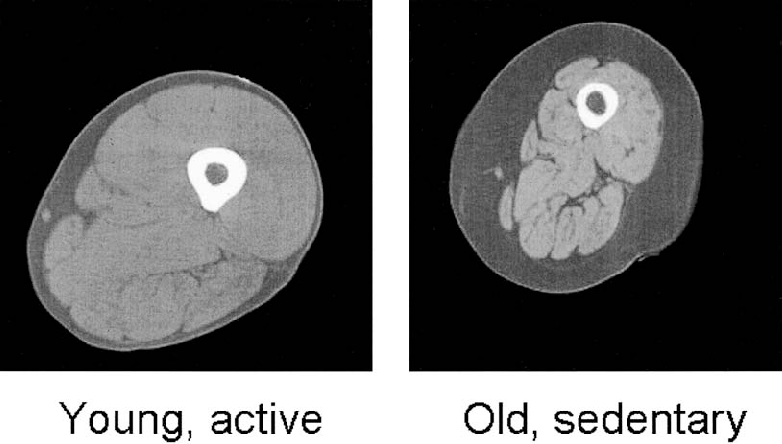This week’s blog discusses a critical topic, muscle, and how muscle loss, also known as sarcopenia, affects cardiovascular health, especially in people over 65 years old.
When we talk about muscle loss and frailty, the overlap is enormous. On a practical basis, they’re mostly the same issue for the elderly population; it begins to take its toll in the mid-60s and beyond. However, sarcopenia might not be evident in some cases. If you look at the images below, you will see the comparison of a 25-year-old versus a 75-year-old, they may have about the same thighs size or leg size; but, in the case of the 25-year-old more of it is muscle; with the 75-year-old, more of it is fat.

There’s another way of seeing it; it’s usually evident, but sometimes not so much. If someone is significantly active, they don’t have a lot of this visible muscle cut in their mid 60’s; you may need to start thinking about the inside of them when they look like this; why is that a big deal? Every time you see sarcopenia, think muscle loss; therefore, aging well. It’s been declared a global health priority by the World Health Organization.
The roles of muscle loss and frailty in late life are receiving increasing attention. By far, the most significant growing demographic worldwide is 65 and above. We’re starting to have some success knocking out the things that kill us at a younger age, even heart attack, stroke, and some other disablers; the population is getting older due to that success.
As we do, frailty and muscle loss are more important and bigger deals; they’re growing each year; let’s clarify: what is the difference between frailty and muscle loss? Frailty is the decline; it’s more of a conceptual issue; it’s the decline of an individual’s homeostatic functional strength and physiologic reserves, which leads to an increase in vulnerability. On the other hand, sarcopenia, or muscle loss, describes the loss of muscle mass and function with age.
When you start thinking about those two definitions, frailty is more functional, sarcopenia or muscle loss is more conceptual. It is easy to see that conceptual definitions have been widely agreed upon, but there’s a lack of consensus on how to measure them.
Science, the literature, and the evidence show that these conditions’ prevalence and clinical impact are high and growing no matter what definition you use. Frailty and sarcopenia are prevalent and usually cause low physical function; now, their features can be very pragmatic. You can start digging down on several things. First, it is essential to look at the muscle mass; Magnetic Resonance Imaging (MRI) might be helpful. Usual walking speed is a simple way to measure, it’s very feasible, and it’s been extensively validated against health outcomes; sit and stand, when somebody’s ability to get up out of a chair and walk provides a lot of information regarding muscular function.
Why is function important? People with frailty into their 60s- 70s and who lead a sedentary life are far more likely to end up institutionalized or dead after stressors like surgery. Frailty appears to outperform traditional anesthetic and surgical risk scores associated with postoperative complications, length of hospital stay, institutionalization, and mortality.
Other risk factors to consider are hypertension and diabetes; these two factors greatly increase your loss of muscle mass as you get older, it’s not clear why, but there are thoughts that the same cardiovascular inflammation that causes endothelial damage may also decrease your blood supply to muscle tissue.
Another critical aspect of preventing sarcopenia and frailty is maintaining mitochondrial mass; one of the best ways is high-intensity intervals; why is mitochondrial mass important? Well, mitochondria are central to the process of aging; the vast majority of mitochondria are located in our large skeletal muscles. They are also known as the cell’s powerhouse, and in the muscle, they help provide enough energy to maintain its function.
Start thinking about what you’re doing to maintain your muscle mass; if you want to age well, if you’re going to avoid disability, and if you’re going to live a long time- you’re going to need the muscle to do it.
If you found this article helpful and want to start taking steps toward reversing your chronic disease, Dr. Brewer and the PrevMed staff are ready to serve you no matter where you’re located.
To find out more, schedule a consult here: prevmedhealth.com
REFERENCES:
- Review Proc Nutr Soc . 2015 Nov;74(4):337-47. Epub 2015 May 25. Aging well: a review of sarcopenia and frailty Victoria L Keevil 1, Roman Romero-Ortuno 2 Affiliations expand PMID: 26004622 DOI: 10.1017/S0029665115002037 https://pubmed.ncbi.nlm.nih.gov/26004622/
- https://prevmedhealth.com/the-secret-life-of-fat-cells-is-it-the-secret-to-longevity/
- https://prevmedhealth.com/the-3-biggest-diet-mistakes-theyre-not-food-choices-part-1/
- https://prevmedhealth.com/the-3-biggest-diet-mistakes-theyre-not-food-choices-part-2/
- https://prevmedhealth.com/is-saturated-fat-unhealthy-is-it-a-big-fat-surprise-big-fat-lies-or-just-confusion/
- https://prevmedhealth.com/resveratrol-sirtuins-nmn-is-david-sinclair-reversing-aging/
- https://prevmedhealth.com/reverse-arterial-plaque-autophagy-inflammation-hdl/
